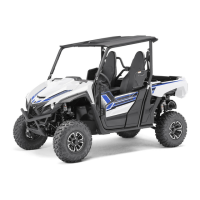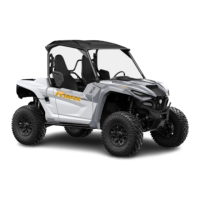Do you have a question about the Yamaha WOLVERINE X4 2021 and is the answer not in the manual?
Recording and locating essential vehicle identification numbers for registration and service.
Identifying the specific vehicle model and key identification number for ordering parts.
Diagrams showing the placement of various warning and specification labels on the vehicle.
Owner responsibility, vehicle familiarization, and pre-operation preparation for safe use.
Safe practices for vehicle operation, load preparation, rollover avoidance, and hazard awareness.
Safety considerations for using genuine Yamaha accessories and aftermarket parts.
Identification of major external and internal components from left and right views.
Diagram illustrating the location and labeling of all vehicle controls and instruments.
Explanation of the main switch, indicator lights, warning lights, and multi-function meter.
Details on Speed Management, Light Switch, Winch, Drive modes, pedals, levers, and knobs.
Information on doors, seats, glove compartment, storage, cup holders, and cargo bed.
Instructions for adjusting front and rear shock absorber spring preload.
Checklist for inspecting brakes, fuel, engine oil, drivetrain, and coolant before operation.
Pre-operation checks for pedals, seat belts, steering, instruments, and passenger handholds.
Procedures for checking tires, wheels, and axle boots for damage or wear.
Guidelines for the initial engine break-in period and how to start the engine safely.
Operation of the drive select lever, reverse driving, and On-Command drive knob for different modes.
Instructions for safely parking the vehicle and loading cargo or trailers.
Understanding vehicle characteristics, driver age/license requirements, and essential rules.
Guidelines for passenger seating, seat belts, occupant protection, doors, and handholds.
Proper use of floorboard, steering wheel, PPE, and basic driving maneuvers like turning and accelerating.
Safe operation on different surfaces, hills, rough terrain, water, and encountering obstacles.
Information on owner's manuals, tool kits, and periodic maintenance charts for service intervals.
Instructions for checking/changing engine oil, transmission oil, gear oils, coolant, and lubrication points.
Procedures for checking spark plugs, air filters, brakes, tires, battery, and fuses.
Guidance for diagnosing and resolving common issues, checking valve clearance and brakes.
Steps for washing and drying the vehicle, including important warnings about brakes and water pressure.
Preventive measures for storing the vehicle for extended periods, including fuel and battery care.
Technical data including overall dimensions, weight, engine configuration, and displacement.
Specifications for engine oil, transmission oil, gear oils, coolant, and air filter requirements.
Details on tire sizes, wheel rims, brake types, and suspension travel.
Information on battery, lights, ignition, charging system, and fuse ratings.
Information on vehicle emission control labels, California regulations, and noise control.
Explanation of the limited warranty, customer responsibilities, and dealer service expectations.
Details on optional extended service plans, coverage benefits, and transferability.
Recording and locating essential vehicle identification numbers for registration and service.
Identifying the specific vehicle model and key identification number for ordering parts.
Diagrams showing the placement of various warning and specification labels on the vehicle.
Owner responsibility, vehicle familiarization, and pre-operation preparation for safe use.
Safe practices for vehicle operation, load preparation, rollover avoidance, and hazard awareness.
Safety considerations for using genuine Yamaha accessories and aftermarket parts.
Identification of major external and internal components from left and right views.
Diagram illustrating the location and labeling of all vehicle controls and instruments.
Explanation of the main switch, indicator lights, warning lights, and multi-function meter.
Details on Speed Management, Light Switch, Winch, Drive modes, pedals, levers, and knobs.
Information on doors, seats, glove compartment, storage, cup holders, and cargo bed.
Instructions for adjusting front and rear shock absorber spring preload.
Checklist for inspecting brakes, fuel, engine oil, drivetrain, and coolant before operation.
Pre-operation checks for pedals, seat belts, steering, instruments, and passenger handholds.
Procedures for checking tires, wheels, and axle boots for damage or wear.
Guidelines for the initial engine break-in period and how to start the engine safely.
Operation of the drive select lever, reverse driving, and On-Command drive knob for different modes.
Instructions for safely parking the vehicle and loading cargo or trailers.
Understanding vehicle characteristics, driver age/license requirements, and essential rules.
Guidelines for passenger seating, seat belts, occupant protection, doors, and handholds.
Proper use of floorboard, steering wheel, PPE, and basic driving maneuvers like turning and accelerating.
Safe operation on different surfaces, hills, rough terrain, water, and encountering obstacles.
Information on owner's manuals, tool kits, and periodic maintenance charts for service intervals.
Instructions for checking/changing engine oil, transmission oil, gear oils, coolant, and lubrication points.
Procedures for checking spark plugs, air filters, brakes, tires, battery, and fuses.
Guidance for diagnosing and resolving common issues, checking valve clearance and brakes.
Steps for washing and drying the vehicle, including important warnings about brakes and water pressure.
Preventive measures for storing the vehicle for extended periods, including fuel and battery care.
Technical data including overall dimensions, weight, engine configuration, and displacement.
Specifications for engine oil, transmission oil, gear oils, coolant, and air filter requirements.
Details on tire sizes, wheel rims, brake types, and suspension travel.
Information on battery, lights, ignition, charging system, and fuse ratings.
Information on vehicle emission control labels, California regulations, and noise control.
Explanation of the limited warranty, customer responsibilities, and dealer service expectations.
Details on optional extended service plans, coverage benefits, and transferability.
| Front Brakes | Dual hydraulic disc |
|---|---|
| Ignition | TCI |
| Front Suspension | Independent double wishbone |
| Rear Suspension | Independent double wishbone |
| Rear Brakes | Hydraulic disc |
| Bed Capacity | 600 lb |
| Towing Capacity | 2, 000 lbs |
| Fuel System | Fuel Injection |












